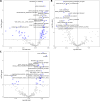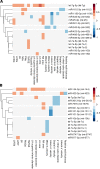MicroRNA composition of plasma extracellular vesicles: a harbinger of late cardiotoxicity of doxorubicin
- PMID: 36517751
- PMCID: PMC9753431
- DOI: 10.1186/s10020-022-00588-0
MicroRNA composition of plasma extracellular vesicles: a harbinger of late cardiotoxicity of doxorubicin
Abstract
Background: The use of doxorubicin is associated with an increased risk of acute and long-term cardiomyopathy. Despite the constantly growing number of cancer survivors, little is known about the transcriptional mechanisms which progress in the time leading to a severe cardiac outcome. It is also unclear whether long-term transcriptomic alterations related to doxorubicin use are similar to transcriptomic patterns present in patients suffering from other cardiomyopathies.
Methods: We have sequenced miRNA from total plasma and extracellular vesicles (EVs) from 66 acute lymphoblastic leukemia (ALL) survivors and 61 healthy controls (254 samples in total). We then analyzed processes regulated by differentially expressed circulating miRNAs and cross-validated results with the data of patients with clinically manifested cardiomyopathies.
Results: We found that especially miRNAs contained within EVs may be informative in terms of cardiomyopathy development and may regulate pathways related to neurotrophin signaling, transforming growth factor beta (TGFβ) or epidermal growth factor receptors (ErbB). We identified vesicular miR-144-3p and miR-423-3p as the most variable between groups and significantly correlated with echocardiographic parameters and, respectively, for plasma: let-7g-5p and miR-16-2-3p. Moreover, vesicular miR-144-3p correlates with the highest number of echocardiographic parameters and is differentially expressed in the circulation of patients with dilated cardiomyopathy. We also found that distribution of particular miRNAs between of plasma and EVs (proportion between compartments) e.g., miR-184 in ALL, is altered, suggesting changes within secretory and miRNA sorting mechanisms.
Conclusions: Our results show that transcriptomic changes resulting from doxorubicin induced myocardial injury are reflected in circulating miRNA levels and precede development of the late onset cardiomyopathy phenotype. Among miRNAs related to cardiac function, we found vesicular miR-144-3p and miR-423-3p, as well as let-7g-5p and miR-16-2-3p contained in the total plasma. Selection of source for such studies (plasma or EVs) is of critical importance, as distribution of some miRNA between plasma and EVs is altered in ALL survivors, in comparison to healthy people, which suggests that doxorubicin-induced changes include miRNA sorting and export to extracellular space.
Keywords: Cardiotoxicity; Childhood acute lymphoblastic leukemia (ALL); Clinical transcriptomics; Doxorubicin; Extracellular vesicles (EVs); Micro-RNAs (miRNAs).
© 2022. The Author(s).
Conflict of interest statement
Authors report no conflict of interest.
Figures





References
Publication types
MeSH terms
Substances
LinkOut - more resources
Full Text Sources
Molecular Biology Databases
Research Materials
Miscellaneous

